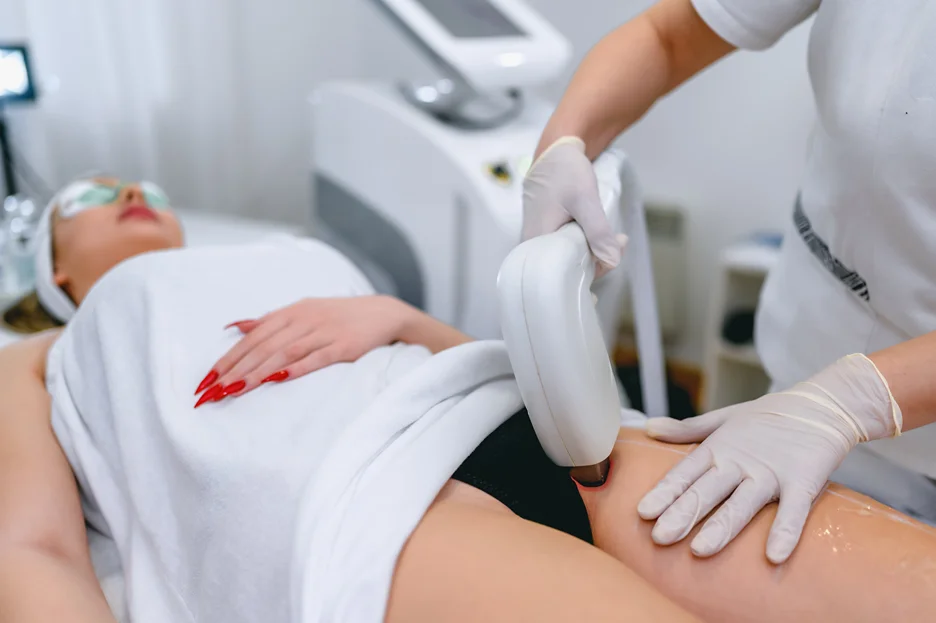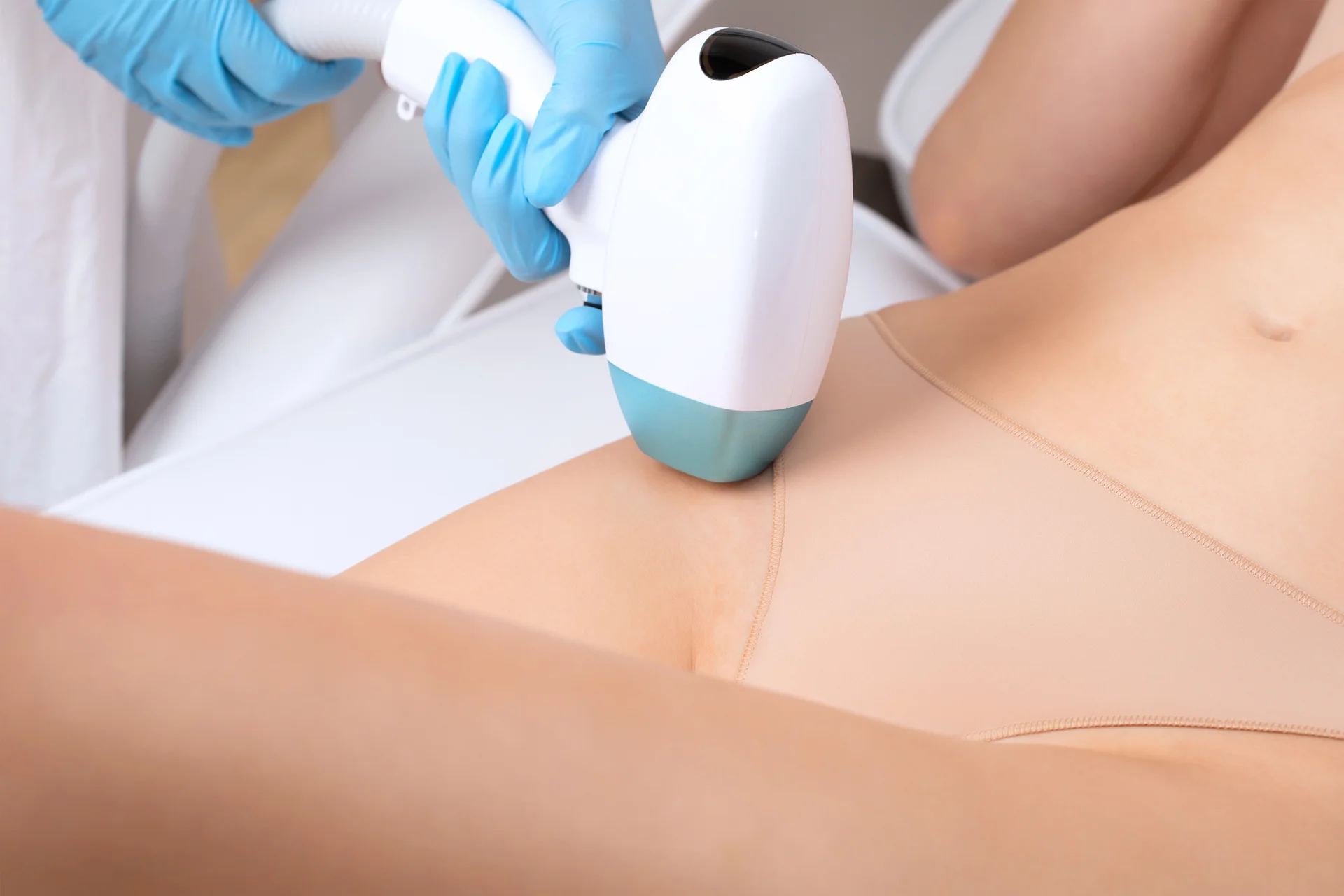Unwanted body hair can cause discomfort, irritation, and embarrassment for many women.
Shaving, waxing, tweezing and other hair removal methods only offer temporary relief and can lead to ingrown hairs, razor burn and skin irritation in delicate areas. For many, vagina laser hair removal has become the solution for silky smooth, stubble-free skin that lasts.
What is Vagina Laser Hair Removal?
Vagina laser hair removal utilizes laser technology to remove unwanted hair from the bikini line, vulva, labia and other intimate areas. It works by using highly concentrated pulses of laser light that target the pigment in hair follicles beneath the skin’s surface. The laser heat damages the hair follicle, disrupting its ability to regenerate and grow new hair.
This results in permanent hair reduction after a series of treatments. Each session removes more of the unwanted hairs until very little regrowth remains. While not completely “permanent,” most women achieve long-term hairlessness or sparser regrowth after a course of laser hair removal treatments.
Why Women Choose Vagina Laser Hair Removal

There are many reasons women seek laser hair removal for their private parts:
- For smoother, stubble-free skin that looks and feels bare 24/7. No more irritation from shaving or ingrown hairs.
- To be able to wear skimpy bikinis, lingerie and bathing suits without pubic hair peeking through. Increased confidence in intimate apparel.
- Avoid embarrassment caused by visible pubic hair in today’s cultural beauty norms. Brazilian waxing is often expected.
- Increased confidence and comfort in intimate situations. No worry about razor stubble or bumps.
- The convenience of not having to continually shave or wax a sensitive area. Laser hair removal provides longer lasting results.
- Swimsuit season readiness. Never worry about pubic hairs sticking out of your swimsuit again.
Am I a Good Candidate for Vagina Laser Hair Removal?
The best candidates for safe and effective vaginal laser hair removal have:
- Dark, coarse hair. Lasers target melanin so work best on darker hair. Fine, vellus hairs won’t absorb enough laser energy.
- Fair to olive skin. Lasers can burn or scar darker skin. The right laser must be used based on your exact skin type.
- No hormonal issues or medication use that stimulates hair growth. Laser is less effective when battling hormone-driven growth.
- No vaginal infections, lesions or open sores. Laser cannot be performed on damaged or inflamed skin.
- No isotretinoin (Accutane) use in the past 6 months. Makes skin more vulnerable to burning.
- No major underlying health issues like diabetes or autoimmune disorders. Increased risk of healing complications.
- No current fever or illness. Being sick lowers your pain tolerance making treatment less comfortable.
- No current tanning or recent sunburns. Darker pigmentation absorbs more laser energy, increasing burn risk.
Schedule a consultation to determine if you are a good candidate based on your medical history, skin type, hair color and treatment goals.
How Does Vagina Laser Hair Removal Work?
Laser hair removal uses selective photothermolysis to damage the hair follicles that produce unwanted hair.
Pulses of laser light target and are absorbed by the melanin pigment in hair follicles. This creates heat that damages the follicle, preventing future hair regrowth.
Several types of lasers can be used:
| Laser Type | Description |
| Nd:YAG Lasers | Effective on all skin types, from fair to dark. – Uses a longer wavelength that penetrates deeper into the follicle. – Best for coarse, dark hair. |
| Diode Lasers | Work well on darker skin. – Penetrates deep into thicker hairs. – Causes less surface irritation than shorter wavelengths. |
| Ruby Lasers | Treats fine hair and light skin effectively. – Not recommended for tanned or darker skin, as it carries a higher risk of burning. |
| Alexandrite Lasers | Targets melanin in hair. – Fast treatment speed, making it suitable for large areas. – Comes with a higher risk of burning or hyperpigmentation in darker skin tones. |
Treatment Techniques
Vaginal laser hair removal requires an expert technician and additional precautions to protect sensitive genital tissue:
- Only licensed professionals should perform the procedure. Improper treatment risks burning, scarring, andinfection.
- The external genital area is treated. The laser beam itself does not enter the vaginal canal.
- Focus is placed on the outer labia, mons pubis, bikini line and areas with hair growth. This is sometimes called a “Brazilian.”
- Cooling techniques are used – either a cooling gel, special device attachment or cryogen spray – to minimize pain and thermal damage to tissue.
- Topical numbing creams placed on the treatment area 30-60 minutes prior help reduce discomfort.
- Technicians carefully manipulate the labia during treatment for full coverage while protecting the thin genital tissue.
- You wear special protective eyewear to shield your eyes from the laser light.
With proper protocols and an experienced provider, vaginal laser hair removal is considered quite safe. However, risks are higher when treatments are improperly administered. Always verify your provider’s experience and credentials.
What Results Can I Expect from Vagina Laser Hair Removal?
With a complete course of treatments, laser hair removal can permanently reduce 70-90% of hair in the treated area. Remaining hairs will be fine and sparse. Maintenance may be needed 1-2 times per year as hormones fluctuate and trigger some re-growth.
However, results depend on multiple factors:
The Number of Treatments – Most patients require 4-6 treatments spaced 4-6 weeks apart for significant long-term reduction. Maximum results take time.
Your Hair and Skin Type – Lasers remove dark, coarse hairs most effectively. Gray, white, blonde or fine hair won’t absorb enough laser energy. Light skin with dark hair shows best results.
Hormonal Issues – Any condition that over stimulates hair growth limits the success of laser removal. Medications like birth control can influence hormones and growth.
Post-Treatment Care – Avoiding sun, irritants, and trauma will maximize results. Using soothing gels and avoiding hot water prevents inflammation.
Genetics – Some women are just more prone to hair growth and regrowth. Maintenance treatments might be needed more frequently.
Be realistic – laser reduction is rarely 100% permanent. With reasonable expectations and consistency, most patients achieve 80-90% hair loss lasting for years.
What is the Vagina Laser Hair Removal Process Like?
Here’s a step-by-step overview of what to expect:
Pre-Treatment Consultation
During your initial consult, your provider will:
- Review your medical history, medications, and health conditions to determine if you are a good candidate.
- Discuss treatment goals and what is realistic for your situation. Manage expectations accurately.
- Examine the treatment area – skin type, hair color, follicles affected – to customize the treatment plan.
- Determine the right laser for your skin tone to prevent side effects.
- Provide cost estimates and payment options based on how many sessions you’ll need.
- Offer skincare advice and recommendations to prepare. This may include avoiding plucking, waxing, tanning, and irritants before treatment. Stop taking photosensitizing medications.
The Treatment
On treatment day:
- No need to shave beforehand. The laser targets the hair follicle below the skin.
- The provider cleans and preps the treatment area. They may trim longer hairs.
- A topical numbing cream is applied and left on for 30-60 minutes to reduce discomfort.
- You put on special safety eyewear to shield your eyes.
- A handpiece glides over the treatment area, delivering pulses of laser energy targeting hair follicles. Most devices have a built-in cooling tip to protect the skin’s surface.
- The treatment takes 15-25 minutes depending on the area size. Most tolerate the mild prickling sensation well.
- Your provider may apply soothing aloe vera gel and review post-care instructions with you.
- Some minor redness and swelling is normal, fading within a day or two.
After Treatment Care
- Avoid sun exposure which can cause hyperpigmentation after laser treatments.
- Do not use hot tubs, baths, saunas or do strenuous exercise that overheats the body.
- No exfoliating scrubs, glycolic acids, or irritants that might cause inflammation.
- Apply provided creams and gels to soothe and cool. Avoid picking or scratching the treated area.
- Hairs will take up to 2 weeks to shed. Do not pluck, wax or remove them. Let them fall out naturally.
- Schedule your next treatment 4-6 weeks later for optimal results.
- Between sessions, hair regrowth is normal. Shaving is okay but avoid other methods like waxing or plucking.
Follow your provider’s post-care recommendations closely to prevent complications and maximize results. Proper aftercare makes a difference.
Does Vagina Laser Hair Removal Hurt?
Most women describe the sensation as a slight pinching or stinging feeling. It only lasts while the laser pulse is being delivered. The area cools again quickly once the pulse ends. While never comfortable, the pain is mild and manageable for most patients.
Here’s why it causes some discomfort:
- The laser is targeting and damaging the hair follicle below the skin. This causes a rapid heat buildup as the melanin absorbs the energy. The surrounding tissue experiences some of this heating impact.
- The genitals are naturally quite sensitive. Pain receptors in the area detect even subtle temperature changes.
- Pubic hair tends to be coarse and dark. The laser settings need to be higher to penetrate these resilient hairs, creating more heat.
- The labia tissue is delicate. There is little cushioning from fat or muscle.
However, techniques are used to minimize discomfort:
- Topical numbing creams – When applied 30-60 minutes prior, these dramatically reduce what you feel. This makes the process much more tolerable.
- Built-in cooling devices – Laser machines often have a cold tip that is held against the skin during the pulse. This protects the surface area from heating too rapidly.
- Shorter treatment times – Individual pulses last just fractions of seconds. The total treatment session takes 15-25 minutes.
- Adjusting settings – Using lower energy levels on sensitive areas and thinner hair can reduce the sting.
While never completely pain free, laser technicians use proven methods to maximize your comfort. The end results are worth tolerating some mild temporary discomfort.
How Many Vagina Laser Hair Removal Treatments Will I Need?
Most patients require 4-6 treatments spaced 4-6 weeks apart to achieve up to 90% long-term hair reduction in the bikini area. Here are some factors your provider will consider when mapping out an individualized treatment plan:
- The Density of Hair Growth – Smaller areas with less hair density may need fewer treatments. Areas with heavy, dense growth will require more sessions.
- Your Hair Color – Coarse, dark hairs are removed most effectively. Fairer hair takes more treatments to damage the weaker melanin pigment.
- Your Skin Tone – Lasers settings must be lower on darker skin to avoid risks. More sessions with conservative settings are safer.
- Medications That Stimulate Hair Growth – Certain medications lead to increased growth rates. More treatments combat this hormone-driven activity.
- Your Pain Tolerance – Sensitive patients may space sessions further apart. Closer sessions produce faster results.
- Treatment Areas – Smaller areas like just a bikini line require fewer treatments than full Brazilian coverage.
Follow your provider’s treatment schedule closely for best results. Maintenance sessions may be needed in the future as hormones fluctuate and trigger some re-growth.
What is the Recovery Time After Vagina Laser Hair Removal?
One of the benefits of laser hair removal is the very short downtime and minimal side effects. Many return to normal activities immediately. Here’s what to expect:
- Mild redness and swelling around the hair follicles is normal and resolves within a few hours after treatment.
- Tenderness, itching or a sunburn-like sensation may last up to 2 days. Topical aloe vera gel brings cooling relief. Avoid irritants.
- Treated hairs will shed over the next 7-14 days. Do not tweeze or wax them. Let hairs fall out on their own.
- Avoid sun exposure, exercise, hot showers, swimming pools and baths for at least 48 hours. This prevents inflammation.
- Skin may flake or crust temporarily around damaged follicles. This is part of the healing process. Don’t pick or scratch.
- Make-up can be applied immediately unless skin is broken or blistered.
- You can shave as soon as desired. It will not impact treatment efficacy.
There is minimal downtime so you can return to normal activities right after treatment in most cases. Follow aftercare instructions to speed healing.
Are There Any Side Effects of Vagina Laser Hair Removal?
When performed properly by an experienced professional, vaginal laser hair removal is very safe with few side effects. However, temporary effects like redness, swelling tenderness and itching are common afterward.
Rare risks include:
- Burns, blisters or scarring – Usually due to technician error or improper laser settings. Choosing an expert provider is key.
- Hyperpigmentation – Darker skin is at increased risk of temporary or permanent discoloration. Avoid sun exposure.
- Hypopigmentation – Loss of skin pigment. Very rare side effect.
- Infection – Extremely uncommon. Proper sterilization and aftercare reduces any risk.
- Local swelling or irritation from topical products – Some numbing creams or aloe gels can cause contact dermatitis in sensitive individuals. Test first.
Discuss any concerns or questions about potential risks with your provider who can walk you through proper protocols for your situation. When performed correctly, vaginal laser hair removal is widely considered safe with minimal undesirable effects.
How Much Does Vagina Laser Hair Removal Cost?
Cost depends on the size of the area treated and number of treatment sessions needed. Some pricing averages:
- Smaller areas like just a bikini line typically range from $150 – $350 per session. Approximately 3-5 sessions are needed.
- A full Brazilian treatment covering the labia, mons pubis, perineum and buttocks costs $400 – $1000 per session. A series of 5-8 sessions is typical.
- Many practices offer discounted package pricing if you pre-pay for a set number of treatments. This saves significantly compared to paying individually.
When calculating total cost, remember to account for:
- The consultation fee – Usually $50 – $100 but sometimes waived if you purchase a package.
- The cost of all recommended treatment sessions, not just one.
- Taxes and any additional service fees the provider charges.
- Tips for your technician – Customary if you are pleased with your results.
Are vaginal laser hair removal costs covered by insurance? Unfortunately, this is considered an elective, cosmetic treatment so insurance providers do not cover the costs. Some healthcare flexible spending accounts (FSA) may reimburse you if funds are available.
How Do I Choose the Right Laser Hair Removal Provider?

Because the vaginal area is so delicate and sensitive, selecting an experienced, reputable provider is extremely important when considering laser hair removal. Avoid “discount” clinics with cheaper prices and highly advertised deals. Laser hair removal is not a service you want to skimp on.
Here’s how to choose a trustworthy provider:
- Look for a Board Certified Dermatologist – Specialized training matters when treating intimate areas. Avoid med spas.
- Verify Licenses and Credentials – Nurses, physician assistants and aestheticians performing the procedure should be licensed with specialized laser training.
- Ask About Their Experience – Look for a clinic that performs many vaginal laser hair removal procedures regularly. Routine experience translates into precision skills.
- Make Sure They Do a Thorough Consultation – An in-depth review of your health, medications, skin type and goals is a sign of a conscientious practitioner.
- Carefully Assess African American/Darker Skin Clients – Choose a provider with a track record of safely treating darker complexions.
- Look for Advanced Laser Technology – Newer devices have built-in skin contact cooling and improved safety features. This optimizes results and minimizes discomfort.
- Check Reviews – Reputable providers have overwhelmingly positive online reviews for vaginal hair removal. Bad reviews related to burning or scarring should be taken very seriously.
Don’t settle on price alone. While vaginal laser hair removal costs can add up, this is a very precision dependent procedure. Paying more for an expert with experience you can trust is a wise investment for your safety, privacy and results.
For many women, vaginal laser hair removal provides immense confidence and comfort. Being able to wear skimpy swimsuits without embarrassing pubic hairs peeking through is life-changing. The freedom to be intimate without razor stubble or ingrown hairs improves sexual experiences.







